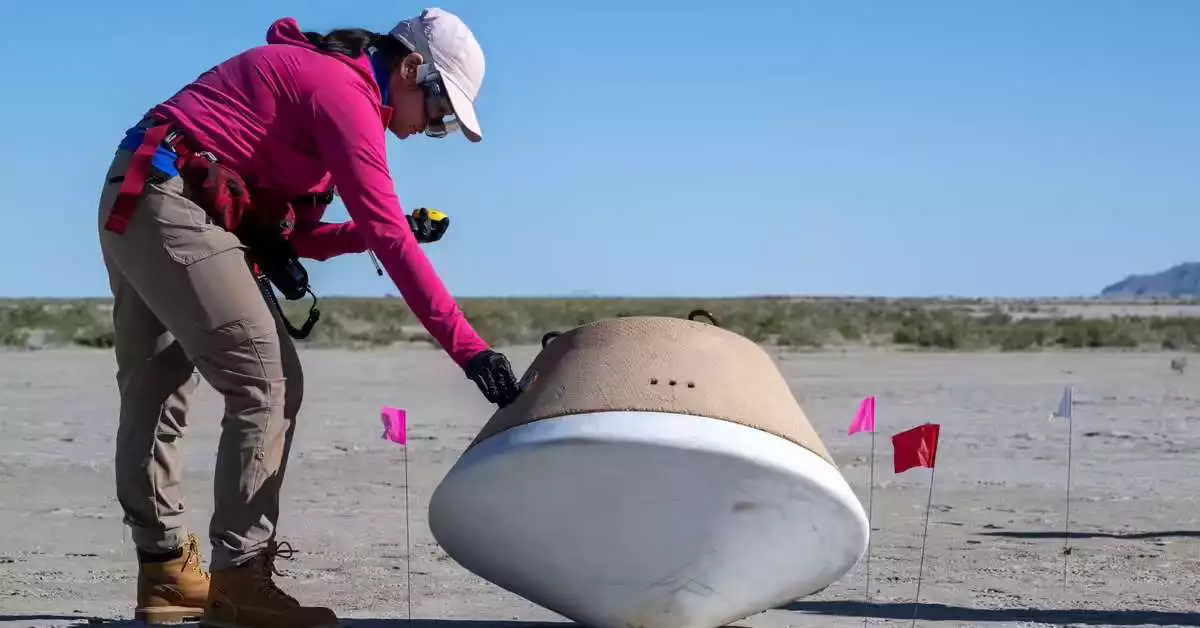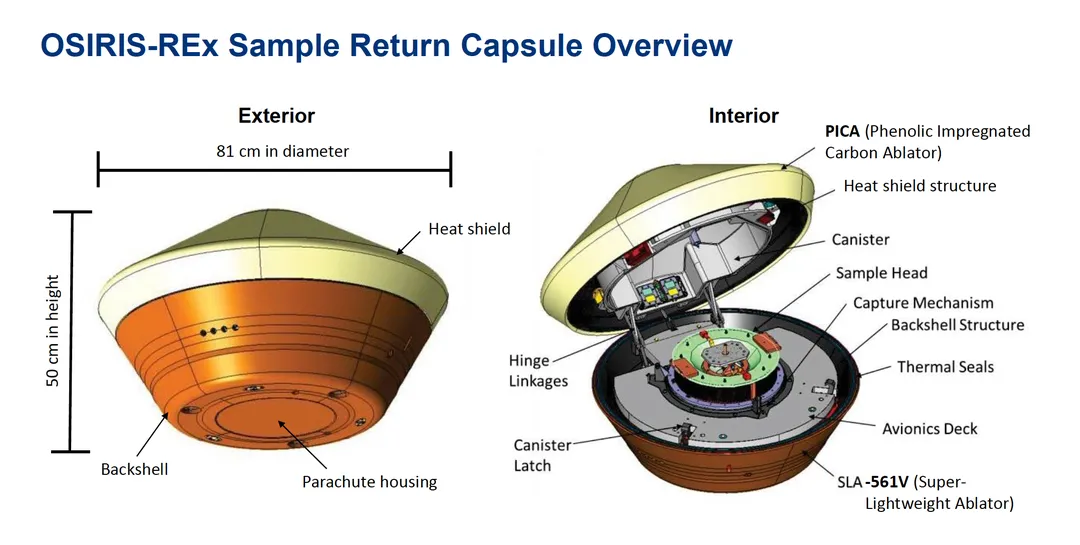This is a significant milestone in space exploration. The OSIRIS-REx mission has successfully collected material from the asteroid Bennu, and the return of the science capsule marks the completion of its primary objective. The material collected from the asteroid is invaluable for scientific research, as it can provide insights into the early Solar System and the formation of celestial bodies.

The safe return of the capsule to Earth is a testament to the precision and expertise of NASA’s mission team. It’s an exciting moment for space science and a step forward in our understanding of the cosmos. Researchers will now have the opportunity to analyze the asteroid material in detail, unlocking potential discoveries about the origins of our Solar System.
Indeed, missions like OSIRIS-REx play a crucial role in unraveling the mysteries of our Solar System’s history. Asteroids are considered remnants from the early days of the Solar System and can provide essential information about the conditions and processes that led to the formation of planets, including Earth.
By studying the material collected from the asteroid Bennu, scientists hope to gain insights into the composition of these ancient celestial bodies, the role they played in the Solar System’s formation, and even the possibility of resources that could be extracted from asteroids in the future.
The safe return of the capsule is an exciting moment for researchers and space enthusiasts alike, as it represents another step forward in our quest to understand the cosmos and our place within it.
The precision required for the OSIRIS-REx mission is truly remarkable and a testament to the incredible advancements in space exploration technology. Operating a spacecraft with such accuracy, especially during a sample collection event on a distant asteroid, is a challenging feat that showcases the expertise and dedication of NASA’s scientists and engineers.
The fact that the spacecraft was able to approach Bennu, collect a sample, and then return to Earth with such precision is a significant achievement. It highlights the capabilities of modern space navigation systems and the ability to conduct complex missions in our solar system.
The large, restricted landing area in the Department of Defense’s Utah Test and Training Range provides a safe and controlled environment for the capsule’s return, ensuring that the valuable asteroid material collected during the mission is preserved and can be studied by scientists for years to come. This successful landing marks an important milestone in NASA’s ongoing efforts to explore and understand our solar system.
The careful handling and protection of the collected sample are critical steps in preserving the integrity of the asteroid material for scientific analysis. The nitrogen purge process is designed to prevent any contamination from Earth’s atmosphere, ensuring that the sample remains in as close to its natural state as possible.
Transporting the sample to the Johnson Space Center in Houston, Texas, is the next step in the scientific journey of this mission. Scientists and researchers will be able to study the sample in detail, doing all sorts of tests to learn more about Bennu and the early days of our solar system.
This mission is a testament to the dedication and precision of NASA’s teams and represents a significant milestone in our ongoing quest to explore and understand the cosmos. The information gathered from the sample could provide valuable insights into the history of our solar system and the origins of life on Earth.
The Quest for Asteroid Samples: Unlocking the Secrets of Life’s Building Blocks
The pursuit of asteroid samples isn’t just a scientific curiosity; it’s a mission to uncover the origins of life’s essential building blocks. Scientists are intrigued by the possibility that these celestial bodies may have played a crucial role in delivering key organic compounds to Earth, which form the basis of life as we know it.
Asteroids are believed to contain trace organic molecules, including amino acids for protein synthesis and nucleic acids that compose our genes. The tantalizing question is whether these critical components for biology were forged within ancient asteroids and transported to our planet from the depths of space.
This theory is well-grounded in the models of our Solar System’s formation. It suggests that while life itself may not have originated elsewhere and journeyed to Earth, the fundamental ingredients necessary for life’s emergence could have been carried here by asteroids billions of years ago.
To validate this hypothesis, scientists require direct access to asteroid material. While spacecraft missions like OSIRIS-REx have allowed initial study of asteroids, comprehensive analysis necessitates a substantial laboratory. The investigation demands sophisticated instruments, such as synchrotrons, which are large particle accelerators over a mile wide and impractical for spacecraft use.
The Quest for Pristine Asteroid Samples: OSIRIS-REx’s Critical Role
The tantalizing question posed by scientists is whether life’s essential building blocks were formed within ancient asteroids and then transported to Earth from the vast expanse of outer space. To investigate this theory, researchers require unadulterated asteroid samples for in-depth analysis.
Meteorites, fragments of matter that originate from space and impact Earth’s surface, have historically served as valuable research subjects. However, this approach presents two significant challenges. Firstly, meteorites lack contextual information about their origins within the Solar System, hindering researchers’ ability to understand their journey and relationships with other celestial bodies. Secondly, meteorites may become contaminated by Earth’s environment during their fiery passage through the atmosphere and subsequent landing.

When searching for trace organic compounds, scientists must ensure that any discoveries originate from space, rather than terrestrial contamination. This demands the acquisition of pristine asteroid samples. OSIRIS-REx is a crucial component of this quest.
By obtaining samples directly from the asteroid Bennu, OSIRIS-REx offers scientists a unique opportunity to study celestial matter uncontaminated by Earth’s environment. This pristine material holds the key to unraveling the mysteries of life’s origins and the potential for extraterrestrial life beyond our planet.
A Global Endeavor: Collaborative Research on Asteroids
The OSIRIS-REx mission, marking NASA’s first successful return of an asteroid sample, is part of a broader international effort. It follows the pioneering missions of the Japan Aerospace Exploration Agency (JAXA) with Hayabusa and Hayabusa 2, both of which retrieved samples from asteroids. While the initial Hayabusa mission collected only a minuscule amount of material, its successor, Hayabusa 2, triumphantly brought back approximately five grams of asteroid material from Ryugu in 2020.
OSIRIS-REx is poised to deliver a substantially larger sample, amounting to around 250 grams from the asteroid Bennu. This extensive sample size enhances scientific capabilities, especially in the pursuit of trace materials. Importantly, researchers view these two missions as complementary rather than competitive endeavors.
ALSO READ: Boosting NASA’s UFO Investigations: The Case for Increased Budget Allocation
Astronomer Dante Lauretta, principal investigator for OSIRIS-REx and a member of the Hayabusa 2 team, underscores the significance of these missions in advancing our understanding of asteroids. Although Ryugu and Bennu share a similar spinning top-like shape, they exhibit notable differences in size and color, with Ryugu being larger and more red in hue, while Bennu is smaller and leans toward a bluish tint. Researchers have yet to decipher the implications of these color variations. However, the analysis and comparison of samples on Earth promise to unravel the similarities and distinctions between these celestial bodies.
The collaborative efforts in the realm of asteroid research transcend national boundaries, fostering a global network of scientific exploration and discovery.
Peering into the Dawn of the Solar System: Unraveling the Mysteries of Early Formation
To fathom the intricate tale of our Solar System’s inception, scientists must extend their gaze beyond the confines of Earth and venture into the cosmos. Star systems, including our own, evolve from colossal clouds of gas that condense into a central star, enveloped by a swirling disk of cosmic material.
This universal narrative is not only corroborated by observations of other star systems but also rooted in the Solar System’s composition. The planets orbit the Sun in a shared direction and within a solitary plane, offering compelling support for the concept of their formation from a solitary disk of matter. A portion of this material coalesced to form planets, while others were ensnared by nascent asteroids, some of which remain intact today.
Determining the Earth’s formation necessitates peering beyond our planet and delving into the Solar System’s annals. Earth’s geological processes, such as erosion and plate tectonics, obliterate and recycle rocks, erasing the planet’s earliest history. Consequently, the Earth’s oldest discovered rocks are approximately 4 billion years old. However, asteroid materials can predate these Earthly samples.
“Asteroids originated around 500 million years earlier than Earth’s oldest rocks. As a geologist, I aspire to journey back to the very origins,” remarked Dante Lauretta. “The exhilarating aspect is that the study of asteroids offers a glimpse into the Solar System’s nascent days.”
Bennu, the celestial body from which OSIRIS-REx meticulously collected a sample, is believed to comprise materials that date back roughly 4.5 billion years—a potential time capsule from the Solar System’s infancy. Yet, the age of Bennu, and by extension the Solar System, remains a mystery until comprehensive analyses unveil its secrets.
OSIRIS-REx’s Next Odyssey: Studying Asteroid Apophis
While OSIRIS-REx’s primary mission of delivering the capsule containing the Bennu sample is complete, the spacecraft remains fully operational, equipped with both power and propulsion capabilities, as well as functioning scientific instruments. Hence, it has been repurposed as OSIRIS-APEX, embarking on a new quest to explore asteroid Apophis. Fortuitously, this asteroid will approach Earth in the coming years, allowing for a rendezvous and comprehensive examination by the spacecraft.
“In April 2029, Apophis is gonna pass within 30,000 kilometers of Earth’s surface, which is about the same distance as our weather satellites orbit,” Dante Lauretta said. “”This is the closest an asteroid has come to Earth in a millennium, and it may even be visible to the naked eye from some locations on Earth.”
OSIRIS-APEX will trail Apophis, observing its orbital trajectory around Earth, and conducting further scientific investigations.
Meanwhile, the precious sample collected from asteroid Bennu will be transported to a specialized facility at NASA’s Johnson Space Center in Houston, Texas. There, scientists will initiate the intricate process of unraveling the sample’s chemical composition.
Nevertheless, the return of the sample to Earth signifies merely the commencement of the scientific exploration. The entire team eagerly anticipates this pivotal moment, which marks the culmination of over a decade of relentless dedication and the commencement of a thrilling new phase.
Lauretta shared his excitement about the upcoming events, stating, “I will be one of the very first individuals on Earth to witness the capsule in its designated location in the desert. It promises to be an emotional moment. We have devoted more than 12 years to the construction, testing, and design of this spacecraft. Thus, it represents the culmination of a very long journey and the prologue to the next chapter.”









